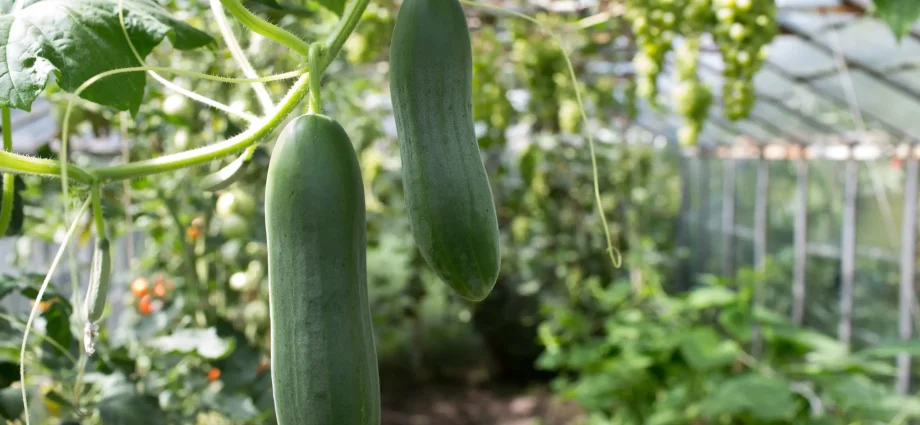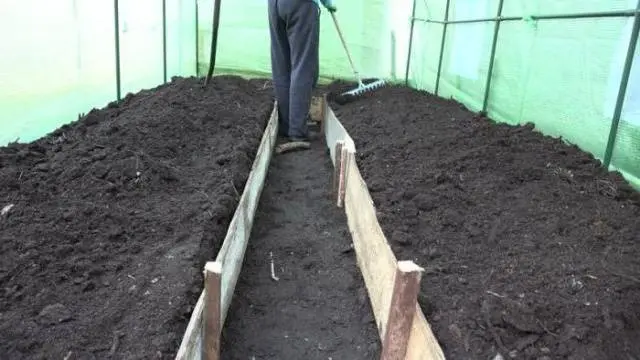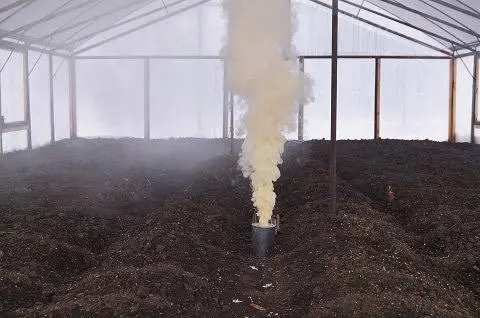Contents
Trying to grow cucumbers in a greenhouse for beginners can be unsuccessful. A habitual culture in closed ground conditions can be capricious, not giving fruit, or get sick and die. This is due to the lack of ultraviolet rays in the early planting periods, too high temperatures in the summer, as well as the elementary mistake of a novice gardener when selecting seeds. Proper plant care also includes such an important event as the formation of a whip.
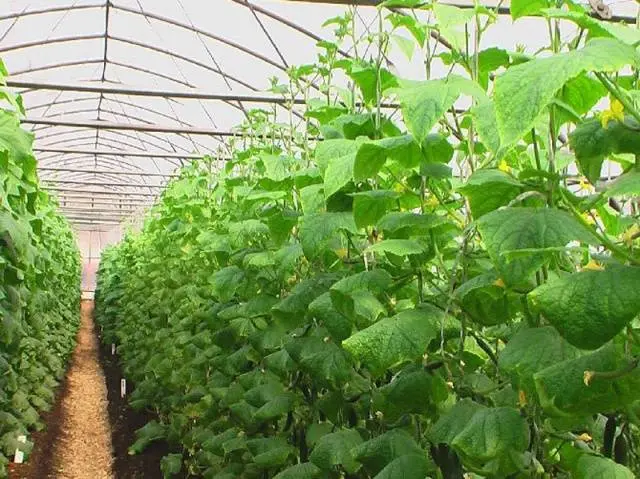
Preparation for planting cucumbers in the greenhouse
If the greenhouse has already been used for growing plants, then its preparation should begin in the fall. Processing must be done, taking into account the type of previous culture. When growing melons, watermelons, zucchini and similar plants from the gourd family, it is best to completely remove the soil, thoroughly clean the equipment parts and treat the greenhouse with antifungal drugs (FAS smoke bombs with sulfur, 7% copper sulphate solution). This will prevent the disease of cucumbers with root and gray rot, powdery mildew, etc.
Cultures unrelated to cucumbers have practically no diseases in common with them, so the preparation of the greenhouse for winter can be done according to the usual rules:
- remove the remains of plants, shed the ridges with a solution of copper sulfate;

- fumigate or spray the interior of the greenhouse with disinfectants and antifungal drugs;

- if early spring planting is planned, prepare the ridges by removing all the soil from them.
Excavation should be done in order to facilitate the work of forming ridges for cucumbers planted in early spring. In an unheated greenhouse, the soil will freeze, making it difficult to cultivate before the start of the season.
Spring preparation of beds in the greenhouse
So that tender shoots do not freeze when the temperature outside drops below 0°C, with early plantings (early April), even in closed ground, it is necessary to use the technology of “warm ridges”. Its essence lies in the fact that fresh manure is loaded into a box or pit, made on the site of a future ridge in a greenhouse. This substance, with a slight compaction, begins to decompose with an intense release of heat, which has been used by gardeners since time immemorial.

The manure needs to be leveled and slightly compacted.
It should not be strongly compacted, as this prevents the flow of oxygen into the biofuel layer and makes heating impossible.
If the manure lumps are frozen, then it is necessary, after loading and compacting, to water the ridge well with very hot water (boiling water) at the rate of 10 liters per 1-2 m². After that, cover its surface with polyethylene or covering material and leave for 2-3 days. During this period, micro-organisms causing rotting begin to thrive in the manure. The bed becomes very hot to the touch, and a slight haze of fumes may appear above it.
The finished layer of biofuel must be covered with fertile soil. The thickness of this layer should be 25-30 cm. Arcs should be installed on top of the ridge right in the greenhouse and a covering material or film should be stretched. After the soil temperature is close to +20°C, you can start sowing seeds or planting seedlings of cucumbers.
Selection and planting of cucumbers in the greenhouse
Not all varieties of cucumbers are suitable for growing indoors. Some of them are bee-pollinated, that is, pollen must be carried by insects. These plants are intended only for the street; it is impossible to get a crop from them in a greenhouse.
Modern hybrids for greenhouses are usually marked “for greenhouses”. In the description of the variety, you can read the incomprehensible word “parthenocarpic”. This means that this variety is able to bear fruit without the participation of insects. It is these cucumbers that are needed for those who want to grow an early vegetable in a greenhouse.
Hybrids created for growing in the northern regions and in Siberia are very undemanding to lighting. Among them are varieties “Buyan”, “Ant”, “Twixie”, “Hally” and many others. More whimsical may be multiple varieties “True Friends”, “Merry Family” and similar ones, which give several ovaries in a knot. Long-fruited hybrids are very good for early plantings. “Malachite”, “Biryusa”, “Stella”.
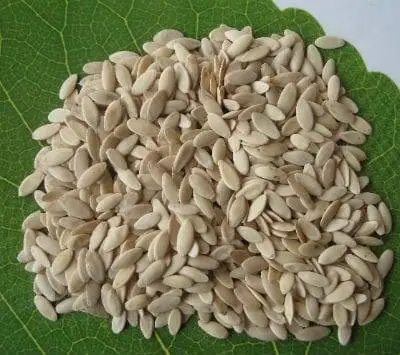
Selected seeds before planting should be soaked for 20-30 minutes in a solution of potassium permanganate (pink) for disinfection. After that, wrap it wet in a wet cloth and leave for 12-24 hours in a warm place (+30 … +35°FROM). During this time, many seeds will hatch, they will have a root. Such planting material should be selected for sowing.

Sowing cucumbers in the ridge
This stage is very important. At the time of sowing, it is important not to break off the tips of the roots, so it must be done very carefully. A hole for a seed can be made with a finger, its depth should not exceed 1,5 cm. The distance between the holes is 70-90 cm. If there are a lot of seeds, you can put 2 seeds in each hole. Water the crops with a little water (0,5 cups per well) and cover the ridge again with covering material.
After 3-5 days, the seeds will germinate and plants with two rounded cotyledon leaves will be visible on the bed. After the seedlings rise above the soil surface, you need to select and leave a stronger plant, and remove the excess. Carefully taken out of the soil, young cucumbers can be transplanted to another place, if necessary. Plant care at this time consists in timely watering with warm water (as soon as the soil surface dries up).

Formation of a whip in a greenhouse
In order to effectively use the areas allotted for planting cucumbers, it is customary to tie them to a trellis and pinch the side shoots according to the scheme.
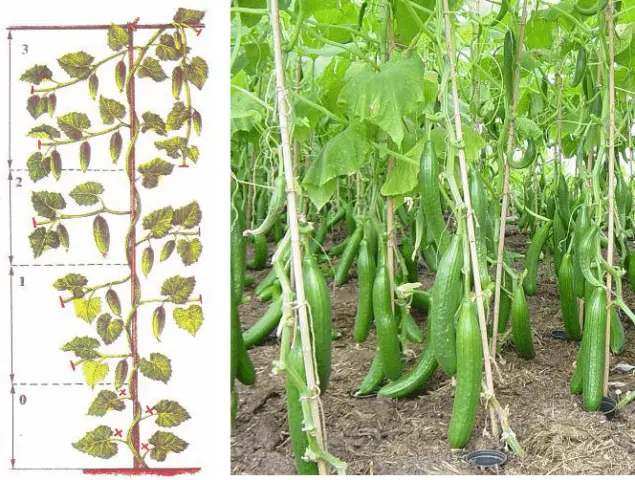
To do this, you need to stretch a horizontal rope or wire over each row of cucumbers. From it down to each bush, lower a thin twine and fasten it at the base of the stem. Until the lash reaches a length of 15-20 cm (4 real sheets), it is enough to wrap it around the twine 1 time.
At this level (null zone) all ovaries and side shoots need to be removed, leaving only the main stem. Pinching should be done immediately, as soon as the germ of the shoot has become noticeable. It does not harm the plant at all. Further, the formation of the whip is done as follows:
- Near the 5th leaf (the first zone), leave the germ of the shoot, allowing it to grow to 1-2 leaves and leave 1 ovary. Pinch off the shoot and do the same up to 8 leaves on the main stem.
- In the next 3-4 nodes (second zone), you can leave 3 leaves and 2 ovaries for each.
- After 11-12 leaves (third zone) and up to the trellis itself, 3-4 leaves and 3 cucumbers are left on the side shoots.
- When the main stem outgrows the height of the trellis, it must be bent over it, lowering it down. Shaping to produce in one stem.
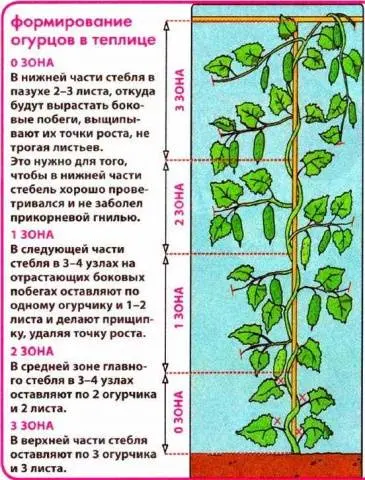
As the stem grows in length and new leaves are formed, the cucumber lash begins to lose the lower leaves. They become lethargic and turn yellow. Starting from the first tiers, they must be removed as they die, preventing rotting or drying out. So, in the lower levels, constant air exchange will be maintained, which will prevent fungal diseases. This is especially true in cool, rainy weather.
Caring for cucumbers in a greenhouse in general is not particularly difficult, even for beginners. The main requirement of this culture is an abundance of moisture. Cucumbers should be watered daily, in the morning, with warm water. They are also very fond of watering the leaves, which increases the humidity of the air.
In hot weather, when the temperature can rise to 30°C, the greenhouse must be ventilated without the formation of drafts. Exceeding this mark makes the formation of fruits slow, and already formed ovaries may fall off. To reduce the temperature, you can shade the greenhouse during the hottest midday hours, constantly monitoring the thermometer. The readings of the device in + 20 … + 25 are considered optimal°C.










